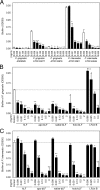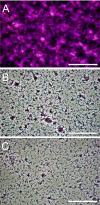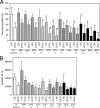Inhibitory effects of lactoferrin on growth and biofilm formation of Porphyromonas gingivalis and Prevotella intermedia
- PMID: 19451301
- PMCID: PMC2715627
- DOI: 10.1128/AAC.01688-08
Inhibitory effects of lactoferrin on growth and biofilm formation of Porphyromonas gingivalis and Prevotella intermedia
Abstract
Lactoferrin (LF) is an iron-binding antimicrobial protein present in saliva and gingival crevicular fluids, and it is possibly associated with host defense against oral pathogens, including periodontopathic bacteria. In the present study, we evaluated the in vitro effects of LF-related agents on the growth and biofilm formation of two periodontopathic bacteria, Porphyromonas gingivalis and Prevotella intermedia, which reside as biofilms in the subgingival plaque. The planktonic growth of P. gingivalis and P. intermedia was suppressed for up to 5 h by incubation with >or=130 microg/ml of human LF (hLF), iron-free and iron-saturated bovine LF (apo-bLF and holo-bLF, respectively), and >or=6 microg/ml of bLF-derived antimicrobial peptide lactoferricin B (LFcin B); but those effects were weak after 8 h. The biofilm formation of P. gingivalis and P. intermedia over 24 h was effectively inhibited by lower concentrations (>or=8 microg/ml) of various iron-bound forms (the apo, native, and holo forms) of bLF and hLF but not LFcin B. A preformed biofilm of P. gingivalis and P. intermedia was also reduced by incubation with various iron-bound bLFs, hLF, and LFcin B for 5 h. In an examination of the effectiveness of native bLF when it was used in combination with four antibiotics, it was found that treatment with ciprofloxacin, clarithromycin, and minocycline in combination with native bLF for 24 h reduced the amount of a preformed biofilm of P. gingivalis compared with the level of reduction achieved with each agent alone. These results demonstrate the antibiofilm activity of LF with lower iron dependency against P. gingivalis and P. intermedia and the potential usefulness of LF for the prevention and treatment of periodontal diseases and as adjunct therapy for periodontal diseases.
Figures






Similar articles
-
Periodontitis, periodontopathic bacteria and lactoferrin.Biometals. 2010 Jun;23(3):419-24. doi: 10.1007/s10534-010-9304-6. Epub 2010 Feb 14. Biometals. 2010. PMID: 20155438 Review.
-
Evaluation of the antimicrobial effect of lactoferrin on Porphyromonas gingivalis, Prevotella intermedia and Prevotella nigrescens.FEMS Immunol Med Microbiol. 1998 May;21(1):29-36. doi: 10.1111/j.1574-695X.1998.tb01146.x. FEMS Immunol Med Microbiol. 1998. PMID: 9657318
-
Lactoferrin inhibits Porphyromonas gingivalis proteinases and has sustained biofilm inhibitory activity.Antimicrob Agents Chemother. 2012 Mar;56(3):1548-56. doi: 10.1128/AAC.05100-11. Epub 2012 Jan 3. Antimicrob Agents Chemother. 2012. PMID: 22214780 Free PMC article.
-
The effect of lactoferrin on oral bacterial attachment.Oral Microbiol Immunol. 2009 Oct;24(5):411-6. doi: 10.1111/j.1399-302X.2009.00537.x. Oral Microbiol Immunol. 2009. PMID: 19702956
-
Lactoferrin and Its Derived Peptides: An Alternative for Combating Virulence Mechanisms Developed by Pathogens.Molecules. 2020 Dec 8;25(24):5763. doi: 10.3390/molecules25245763. Molecules. 2020. PMID: 33302377 Free PMC article. Review.
Cited by
-
Scratching the surface - tobacco-induced bacterial biofilms.Tob Induc Dis. 2015 Feb 10;13(1):1. doi: 10.1186/s12971-014-0026-3. eCollection 2015. Tob Induc Dis. 2015. PMID: 25670926 Free PMC article.
-
Porphyromonas Gingivalis May Seek the Alzheimer's Disease Brain to Acquire Iron from Its Surplus.J Alzheimers Dis Rep. 2021 Jan 20;5(1):79-86. doi: 10.3233/ADR-200272. J Alzheimers Dis Rep. 2021. PMID: 33681719 Free PMC article.
-
Effects of orally administered lactoferrin and lactoperoxidase on symptoms of the common cold.Int J Health Sci (Qassim). 2018 Sep-Oct;12(5):44-50. Int J Health Sci (Qassim). 2018. PMID: 30202407 Free PMC article.
-
Interdependence between iron acquisition and biofilm formation in Pseudomonas aeruginosa.J Microbiol. 2018 Jul;56(7):449-457. doi: 10.1007/s12275-018-8114-3. Epub 2018 Jun 14. J Microbiol. 2018. PMID: 29948830 Free PMC article. Review.
-
Lactoferrin: A Natural Glycoprotein Involved in Iron and Inflammatory Homeostasis.Int J Mol Sci. 2017 Sep 15;18(9):1985. doi: 10.3390/ijms18091985. Int J Mol Sci. 2017. PMID: 28914813 Free PMC article. Review.
References
-
- Adonogianaki, E., N. A. Moughal, and D. F. Kinane. 1993. Lactoferrin in the gingival crevice as a marker of polymorphonuclear leucocytes in periodontal diseases. J. Clin. Periodontol. 20:26-31. - PubMed
-
- Aguilera, O., M. T. Andrés, J. Heath, J. F. Fierro, and C. W. I. Douglas. 1998. Evaluation of the antimicrobial effect of lactoferrin on Porphyromonas gingivalis, Prevotella intermedia and Prevotella nigrescens. FEMS Immunol. Med. Microbiol. 21:29-36. - PubMed
-
- Ainscough, E. W., A. M. Brodie, and J. E. Plowman. 1979. The chromium, manganese, cobalt and copper complexes of human lactoferrin. Inorg. Chim. Acta 33:149-153.
-
- Alugupalli, K. R., and S. Kalfas. 1995. Inhibitory effect of lactoferrin on the adhesion of Actinobacillus actinomycetemcomitans and Prevotella intermedia to fibroblasts and epithelial cells. APMIS 103:154-160. - PubMed
-
- Alugupalli, K. R., and S. Kalfas. 1996. Degradation of lactoferrin by periodontitis-associated bacteria. FEMS Microbiol. Lett. 145:209-214. - PubMed
MeSH terms
Substances
LinkOut - more resources
Full Text Sources
Other Literature Sources
Molecular Biology Databases
Research Materials

